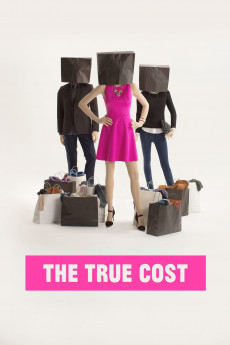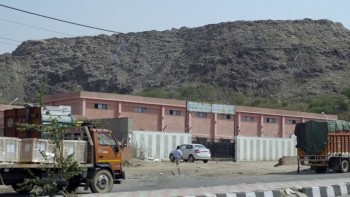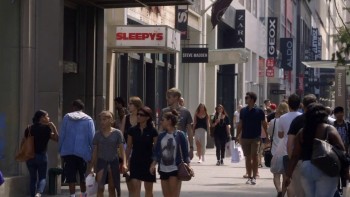This movie is biased. A lot. But that doesn't mean that what it isn't saying is right.
Because it is.
"The True Cost" is a movie about the clothing industry and the costs the fast fashion world we live in today has, with uncontrolled consumerism and a total lack of understanding of the processes behind the clothes we wear.
And the movie does a great job in showing many aspects behind the product you are wearing. It tells the story of many of the workers, and also owners of industries, and brings home many points, from how the workers labor is made cheap, or how they have to work in horrible environments, to the illnesses people get because of the way the industry works or the consequences for the environment.
The movie unashamedly points to out-of-control consumerist capitalist society as the big reason behind what is happening, with people just buying for the sake of it, and society sending constant messages about the need of buying and changing clothes constantly. It is, as said above, a movie that doesn't hide its agenda. But, at the same time, it is absolutely true that the work conditions of the workers of the industry are terrible, that the environment is suffering because of the industry, and that we buy too many things we don't really need.
This is a movie necessary to think a little bit about what's behind the clothing industry, what we don't see/don't want to see, and how we should care about it because we should care about other humans and the world we live in.
The True Cost
2015
Action / Biography / Documentary / Drama / News
The True Cost
2015
Action / Biography / Documentary / Drama / News
Plot summary
Film from Andrew Morgan. The True Cost is a documentary film exploring the impact of fashion on people and the planet.
Uploaded by: OTTO
September 12, 2023 at 05:31 AM
Director
Top cast
Tech specs
720p.BLU 1080p.BLUMovie Reviews
Really good movie about the clothing industry
Makes you think about the clothes you buy
In this examination of the clothing industry, director Andrew Morgan says that he knew nothing about the industry before embarking on making the movie. Maybe he offers that fact in support of initial objectivity to justify presenting an accumulation of damning evidence showing objectionable conduct in all components of the industry.
In 2013 the spotlight was placed on the apparel industry in the aftermath of the of the Rana Plaza building collapse in Bangladesh where over 1000 workers died. The apparel industry was on the hot-seat after Rana Plaza and I wish there would have been discussion in this movie about how the brands using that building reacted to the event.
A case is made that most of the evils of the industry are propagated by the desire to reduce the price point of all products, and this permeates all facets of the industry--all the way from cotton production, pesticide use, improper waste disposal, pollution of soil and rivers, factory conditions bordering on slave labor, and potential health issues.
Cheap labor is seen as the driving force behind the fact that most all apparel manufacturing is now done in poorer countries. In 1950 over 95% of clothing sold in the United States was produced in the United States. Today that figure is 3%.
It's hard to see how to break the vicious cycle of downward pressure on price--if a factory does not knuckle under to price demands, the companies blackmail them by saying that they will just go to a country that can meet their demands. Some of the industry executives in third world countries interviewed here say that having apparel factories in their country is a boon to them in that they offer some employment for people who would otherwise likely have no employment. The downside of capitalism is much on display here.
Some statistics stood out for me: the average western consumer throws away 85 pounds of clothing a year (amounting to 11 million tons a year in the U.S.) and only about 10% of these are recycled. This means that much of this clothing winds up in mountains of waste that take years to biodegrade. And, yes, these mountains of waste mostly wind up in poorer countries. No mention is made of the environmental toll taken to ship clothes, both new and used, all over the world.
Some relief from the downbeat tone is given by giving a nod to the few companies that are trying to buck the trend, like a Texas cotton farm producing organic cotton and some fair trade companies like People Tree. These small efforts offer the only optimism presented in the movie.
Not all change needs to come from the industry, since consumers bear some responsibility. A more judicious approach to buying clothes is called for--the "wear once and toss" use is a part of the problem. Apparel consumption is up over 400% in the last couple of decades. Consumers are urged to cut back on their purchases and to recycle rather than toss. But, as evidence of how complicated it is to improve the situation, a cutback in consumer spending could ultimately make things worse by closing factories, resulting in more unemployed and more downward pressure on price.
As long as consumers seek the lowest prices, and you can't blame them, this situation will continue until movies like this, and other educational efforts, provoke a consumer backlash against the main offenders. Another tipping point toward industry correction, beyond consumer awareness, could come when the collateral environmental damage reaches such crisis proportions that there is a citizen rebellion.
Little mention is made of specific brands and their practices, perhaps for fear of legal actions. I wanted to know specifics. There were a couple of images of Levi's stores, implying guilt by association with the overarching negativity. I noticed that director Morgan was wearing a pair of Levi's. And Levi's was not operating out of Rana Plaza and I think they are more concerned about corporate responsibility than most brands. Knowing which brands are the best and which are the worst would at least provide some guidance for people to gravitate to the better brands. You would think that above all Nike would have been mentioned.
It would be interesting to examine the true cost of almost any industry--the oil and gas industry is an obvious choice. Tracing the true cost of any manufactured good would be enlightening, like what it takes to manufacture a car, what it takes to support that car once it is on the road, and what happens when it has reached the end of its useful life. Or cell phones, or ...
It's hard to leave this movie in a positive frame of mind.












